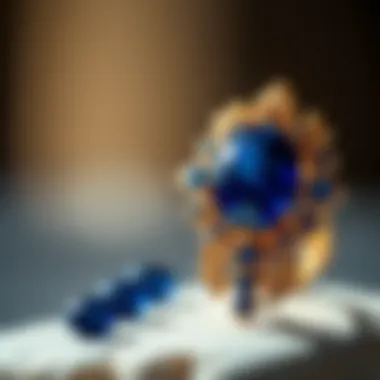The September Birthstone: A Guide to Sapphire


Intro
Sapphires, shimmering gems of rich blues and other hues, hold a significant spot in the realm of gemstones. Celebrated as the birthstone for September, these precious stones have captivated admirers for centuries not just for their beauty but for the depth embedded in their history and symbolism.
This article delves into various facets of sapphires, from their defining characteristics to their historical relevance and cultural impact. With sapphires being favored in fine jewelry and sought after as investment pieces, understanding their intrinsic value and the stories they convey adds a compelling layer to their allure. Let’s embark on a journey to uncover what makes sapphires the gemstone for this month and beyond.
Prelims to September Birthstone
September is more than just the ninth month of the year; for many, it carries a gem that symbolizes elegance and depth—the sapphire. As the birthstone for those born in this month, sapphires possess a storied past that interweaves human culture with nature's artistry. Understanding what a birthstone is as well as the unique attributes of sapphires enables a deeper appreciation of this gemstone's significance.
Definition of Birthstones
Birthstones have been treasured for centuries, often linked to specific months, each stone thought to bring certain qualities or benefits to the bearer. The concept can be traced back to ancient traditions, where various stones were ascribed mystical powers. The modern list of birthstones was formally established in the 20th century, making these gems more than mere adornments but important symbols of identity and personal significance.
To many, wearing a birthstone serves as a source of pride and a token of luck. For September, it is the sapphire, renowned for its beauty and resilience. These stones can be powerful statements of individuality and represent milestones or celebrations such as birthdays or anniversaries.
Overview of Sapphires
Sapphires, part of the corundum family, are predominantly blue but can come in a riot of colors, except red, which are categorized as rubies. The allure of sapphires stems not only from their vivid hues but also their remarkable hardness, second only to diamonds among natural gemstones. This durability makes them a popular choice in jewelry that stands the test of time.
Over the ages, sapphires have adorned royals and been featured in historic artifacts, symbolizing nobility and wisdom. In current trends, they are seeing a resurgence in popularity, both in fashion and as investment stones. Their versatility in jewelry—from engagement rings to statement pieces—defines their enduring appeal. Sapphires are not just gemstones; they are heirlooms in the making, carrying stories waiting to be shared.
"A sapphire is not just an adornment; it is a legacy, a story, a piece of nature imbued with human history."
Understanding sapphires in the context of being September's birthstone allows enthusiasts and collectors to appreciate not only the stone's physical beauty but its rich heritage and the symbolism attached to it.
The Physical Properties of Sapphire
Understanding the physical properties of sapphire is key for anyone delving into its beauty and value. These characteristics not only affect the aesthetic appeal of this stunning gem but also determine its durability, making it a sought-after choice for jewelry and investment. For gemstone enthusiasts and collectors, the nuances of what makes sapphire unique can greatly influence their appreciation and selection of this precious stone.
Color Variations
Sapphires are often revered for their rich color palette, ranging from the classic deep blue to striking hues like pink, yellow, and even green. The most recognized color, blue sapphire, has cemented its status as a symbol of elegance and nobility. Interestingly, the blue color occurs due to the presence of iron and titanium during the formation process.
However, sapphires can also showcase shades like purple, which is linked to the presence of chromium, and orange, commonly referred to as "padparadscha". It's worth noting that the color saturation and tone play crucial roles in determining a sapphire's desirability and value. An intense color with good clarity can elevate a sapphire in the eyes of collectors and jewelers alike.
"Color is the most important element in the gemstone world. The deeper, the better – but that still depends on personal taste!"
Hardness and Durability
One of the standout features of sapphire is its hardness, rated 9 on the Mohs scale. This makes it one of the hardest gemstones available, second only to diamond. Such superior hardness contributes to its durability, meaning it can withstand daily wear better than many other stones. This quality is particularly appealing for engagement rings and other jewelry that are subjected to regular use.
Sapphire's durability extends beyond daily wear. It is resistant to scratches and chips, which can often plague softer stones. When properly cared for, a sapphire can last a lifetime, maintaining its luster and appeal. This longevity is something both gem collectors and designers seek in their selections, making sapphire a wise choice for investment as well.


Clarity and Cut
While color is a significant factor, clarity and cut also play pivotal roles in determining a sapphire's overall beauty and value. Clarity refers to the presence of inclusions or blemishes within the stone. Superior-quality sapphires should have minimal inclusions, as these can detract from the stone's brilliance.
The cut, on the other hand, relates to how well the sapphire has been shaped and faceted, affecting its sparkle and light performance. An expertly cut sapphire will reflect light beautifully, enhancing its color and clarity. Different cuts emphasize various characteristics of the stone, from the traditional round cut to more contemporary shapes like the cushion or marquise. A well-cut sapphire not only highlights its inherent beauty but also elevates its market value considerably.
Historical Significance of Sapphires
The sapphires have always been more than just mere jewels; they carry stories that stretch back thousands of years. This section delves into the rich historical significance of sapphires, revealing how they have been integrated into myths, beliefs, and prestigious roles throughout various cultures. For gemstone enthusiasts and collectors alike, understanding this history can enhance the appreciation of this extraordinary stone.
Ancient Beliefs and Uses
Throughout history, sapphires have been revered across different cultures for their assumed mystical properties. In ancient Babylon, it was believed that wearing a sapphire would bring divine favor. People thought that the stone could protect its wearer from envy and harm, thus making it a sought-after amulet.
- Mythological Ties: The Greeks associated sapphires with Apollo, the god of wisdom, light, and reason. They crafted talismans out of sapphires to invoke protection and clear thought.
- Healing Properties: In medieval Europe, sapphires were believed to have healing properties. It was common to grind the stone into powder and mix it with other remedies. The belief was that this would enhance the efficacy of the treatments, especially for ailments related to the eyes and mental health.
Sapphires were also thought to have the power to ward off evil spirits. People placed them near altars or wore them as jewelry in hopes of keeping malevolent forces at bay. Such deep-rooted beliefs highlight how central these gems were in the lives of ancient civilizations.
Sapphires in Royalty
The allure of sapphires is distinctly tied to their presence in royal circles. From ancient times to the modern era, these gemstones have adorned crowns, rings, and other regal regalia, symbolizing sovereignty and prestige. Notable historical accounts include:
- British Crown Jewels: The famous St. Edward's Sapphire is set in the Imperial State Crown, worn by British royalty during ceremonies. Its vibrant hue signifies the status and power associated with the monarchy.
- Louis XVI of France: The king was renowned for his affinity for luxurious sapphires, which were featured prominently in his royal adornments, reinforcing the stone's connection to authority in France.
- Princess Diana: In contemporary history, Diana, the Princess of Wales, wore an exquisite sapphire engagement ring, which later became a beloved symbol of her legacy. Today, this same ring is worn by Kate Middleton, showcasing the endurance of sapphires in royal families.
"Sapphires are not just gemstones; they are a testament to the heritage of power and grace that transcends time."
As these examples illustrate, sapphires have consistently been symbols of wealth, wisdom, and authority. Their historical significance continues to resound today, making them not just birthstones for September, but also enduring symbols of ambition and nobility.
Symbolism and Meaning of Sapphire
Sapphires carry a rich tapestry of symbolism that stretches across cultures and eras. Their striking blue hue, though often the most recognized, is merely one part of the story. In various traditions, sapphires embody wisdom, nobility, and protection—qualities that elevate them beyond mere aesthetics. This article aims to delve into the essence of sapphire, particularly in its role as a September birthstone.
Wisdom and Nobility
Sapphires are often associated with wisdom and nobility. The deep blue color of the stone is said to reflect the clarity of the mind and the integrity of spirit. In historical contexts, leaders and royalty adorned themselves with sapphires as a visual testament to their stature. For example, many crowns and thrones were embellished with these precious stones, symbolizing that the holders were not just rulers but wise and just guardians of their people.
This connection to wisdom is not just ceremonial. Many believe that wearing sapphire can assist in clear thought and good decision-making. Some even say that the stone enhances intuition; a worthy trait for anyone looking to make life choices that resonate with authenticity and purpose. Insights gained from those who treasure sapphires suggest that when inherited as family heirlooms, these stones carry with them not only beauty but also the wisdom of generations.
"A sapphire will be your best companion when you seek clarity in mind and spirit."
Additionally, sapphires have roots in religious significance as well. In Christianity, they were often believed to represent heaven and the divine favor. Those who held such stones in reverence believed they could offer guidance and light in moments of uncertainty.
The nobility associated with sapphires makes them a choice gem for engagement rings and other significant life events, embodying the properties and values one wishes to share with their loved ones.


Protection and Purity
Sapphires are not just revered for their beauty but also for the protective qualities they are said to possess. Across different cultures, sapphires have been considered safeguarding stones against evil thoughts and influences. Ancient warriors often carried them into battle, believing the stones would offer them protection and strength.
In many cultures, it is believed that sapphires can ward off negative energies and bring forth tranquility. These stones have been identified in the healing traditions of various societies, where they are thought to purify the body and mind. It was common to wear sapphire as a talisman for protection against any harm. Some folks have even suggested keeping them in one's environment or home to foster peace and serenity.
The connection to purity further underscores the meanings attributed to sapphires. Their vibrant color and clarity serve as an emblem of innocence and virtue. This has positioned sapphires as a popular choice in wedding jewelry, representing the purity of vows shared between partners.
As you can see, sapphires carry depths of meaning, far exceeding their physical allure. They are not simply precious stones; they encapsulate the virtues and values that individuals and cultures hold dear, continuing to inspire and enchant generations.
Cultural Relevance of September Birthstone
The cultural relevance of sapphires as the September birthstone extends far beyond its vibrant beauty. Understanding this connection offers insights not only into the gemstone itself but into the myriad of traditions and beliefs that surround it. From ancient civilizations to modern-day practices, sapphires continue to hold significant value in various cultures. This section aims to explore how sapphires have been valued through the ages, revealing a rich tapestry of meanings and uses that reflect each culture's values and aesthetics.
Sapphire in Different Cultures
Across different cultures, sapphires have taken on diverse meanings, often reflecting social status, spirituality, and a connection to the divine. In ancient Persia, for instance, it was believed that the blue sky was a direct result of sapphires reflecting their color. This belief tied the gemstone not just to the earthly realm but to the heavens, representing a connection between humanity and the divine.
Meanwhile, in ancient India, sapphires were among the Navaratna, or nine precious stones, which held immense spiritual significance, believed to bring peace and prosperity. A well-cut sapphire was a mark of wealth and power, and it was often worn by royalty.
In the Western cultures, sapphires came to symbolize fidelity, truth, and nobility. This symbolism has been reinforced by their use in engagement rings, most famously worn by Princess Diana and now the Duchess of Cambridge, Kate Middleton, making it a modern emblem of everlasting love.
Here’s a quick glance at how different cultures regard sapphires:
- Persian Culture: Linked to heaven and divine favor.
- Indian Tradition: Spiritual significance as one of the nine sacred stones.
- Western Lore: Symbol of fidelity and devotion.
- Medieval Europe: Believed to protect against envy and harm.
Each of these interpretations has helped to build a robust cultural identity surrounding sapphires, making them more than just a beautiful stone; they represent aspirations, beliefs, and values that define humanity.
Sapphire and Astrology
Astrology offers another lens through which the significance of sapphires can be understood. Astrologers traditionally align stones with specific zodiac signs. For those born in September, the sapphire is linked with Virgo, symbolizing wisdom and purity.
Here’s a brief overview of how sapphire is perceived in astrological practices:
- Virgo: Those born under this sign are said to benefit from sapphire's properties as it promotes clarity in thought and enhances analytical abilities.
- Planetary Relations: Sapphires are often associated with Saturn, known for its themes of discipline and responsibility. This connection is believed to enhance focus and self-control for lovers of astrology.
- Healing Properties: In astrology, sapphires are thought to bring forth healing energies, promoting mental health and emotional stability. This transformative power allures many gemstone enthusiasts, who seek to harness these attributes for personal growth.
Ultimately, the cultural and astrological significance of sapphires highlights a complex interplay of meanings and values that are consistently revered across different times and places. The gem’s versatility continues to captivate both admirers and collectors, reinforcing its place as a treasured symbol of beauty and depth.
Sapphires in Jewelry
Sapphires hold a distinctive place in the world of jewelry, cherished not only for their striking appearance but also for their enduring qualities. Jewelry made from this gemstone is more than just an accessory; it embodies elegance, status, and personal significance. On a deeper level, sapphires speak to cultural, historical, and emotional narratives that resonate with many people. This section dives into the various jewelry styles featuring sapphires and the necessary care to maintain their beauty and integrity.
Popular Jewelry Styles


When discussing sapphire jewelry, it’s imperative to recognize the diversity in styles. From statement pieces to subtle accents, sapphires find their way into many designs:
- Engagement Rings: Sapphires are a compelling choice for engagement rings, offering a durable alternative to traditional diamonds. A sapphire’s deep, royal blue hue (or any of its color variations) can symbolize loyalty and trust in a relationship. Rings like the iconic Prince William's engagement ring, once belonging to Princess Diana, showcase how sapphires can take center stage in these significant tokens of love.
- Earrings: Sapphires in earrings can range from simple stud styles to elaborate chandelier designs. They can be set in gold or silver, making them versatile for all occasions. The sparkle of a sapphire enhances the overall elegance, making these earrings a favored choice for special events.
- Necklaces and Pendants: Sapphire pendants can tell a story all their own, whether through intricate settings or colorful combination with diamonds or pearls. A sapphire necklace can be worn for both casual outings and formal occasions, making it a timeless piece in any jewelry collection.
- Bracelets: Cuff bracelets that incorporate sapphires often make bold statements. They highlight the wearer's style, effortlessly transitioning from day to night.
Each of these styles showcases not just the stone’s beauty but also the skill and creativity of the jewelers who design them. Remember, the allure of sapphire jewelry lies in its ability to complement various outfits and occasions.
Care and Maintenance of Sapphire Jewelry
Maintaining the integrity of sapphire jewelry is crucial in preserving its beauty over time. Here are some tips to ensure your sapphire pieces stay as stunning as the day you bought them:
- Regular Cleaning: Soak your sapphire jewelry in a warm, soapy water solution. Gently scrub with a soft brush to remove dirt and oils. Avoid harsh chemicals as they can cause discoloration.
- Avoid Scratching: Although sapphires are durable, they can still get scratched. Store them separately from other jewelry to prevent scratching your sapphires or other pieces. A soft pouch or a lined jewelry box can work well.
- Inspection: Periodically check the settings and clasps of your sapphire jewelry. Ensure that the stones are secure, as losing a precious stone can be heartbreaking.
- Safe Storage: When not wearing your sapphire jewels, store them in a cool, dry place. Heat and humidity can affect the quality of the stones and their settings.
"A little care can go a long way in maintaining the allure of sapphire jewelry. It's worth it to invest time, as these pieces often carry sentimental value alongside their monetary worth."
By following these simple guidelines, you can ensure that your sapphire jewelry continues to sparkle and shine, whether it’s a treasured heirloom or a modern design. Sapphires not only enrich your collection but also weave intricate narratives into the fabric of your life.
Investing in Sapphires
Investing in sapphires presents a unique opportunity for both gemstone enthusiasts and financial investors. These stunning stones not only hold considerable aesthetic appeal but also have the potential for significant monetary value over time. As we delve into this topic, it’s essential to explore various aspects, including market trends, valuation methods, and factors that influence sapphire prices. Understanding the nuances of sapphire investment can unlock a trove of insights for those looking to enhance their collections or build profitable portfolios.
Market Trends and Valuation
The sapphire market, like other gemstone markets, is influenced by global trends, economic situations, and even cultural shifts. In recent years, there’s been a noticeable uptick in demand for natural sapphires. This hasn’t just driven prices upwards; it has also led to increased scrutiny regarding the quality and origins of these stones. Potential investors should keep an eye on some specific trends:
- Sustainability: Consumers are becoming more conscious about where their gemstones come from. Ethically sourced sapphires are in high demand, affecting their marketability positively.
- Color preferences: The color spectrum of sapphires can vary significantly. Rich, vibrant blues are still favored, but other colors like pink, yellow, and green are gaining traction. Understanding current consumer preferences can inform purchasing decisions.
- Digital marketplaces: The rise of online platforms allows for greater accessibility, making it easier to buy and sell sapphires. However, it’s crucial to verify the credibility of sellers in such environments.
Valuation can be tricky due to the subjective nature of gemstones. Factors such as clarity, carat weight, and cut quality are assessed, but the absence of a universal grading system complicates this process. Investing in gems considered to hold value over time, such as natural, untreated sapphires, is generally a safer bet.
Factors Influencing Sapphire Prices
The price of sapphires can hinge on several key factors, making it crucial for investors to do their homework:
- Origin: Sapphires from specific locations, like Kashmir or Burma, often command higher prices due to their rarity and historical significance.
- Treatment: Untreated gems are typically worth more than their treated counterparts. Be sure to ask about any treatments the sapphire has undergone, as this can greatly influence its value.
- Market demand: Prices can fluctuate based on overall demand. During economic downturns, luxury items like sapphires may see reduced interest, leading to price drops.
- Trends in design: The popularity of sapphires in fashion can lead to spikes in prices. An increase in demand for sapphire jewelry can push up the value of loose sapphires as well.
"The gemstone market is ever-changing. Understanding these dynamics can make a significant difference in investment outcomes."
In summary, investing in sapphires offers a blend of beauty and potential profit. Awareness of market trends and valuation factors is vital in navigating this alluring but complex field.
The End
As we draw the curtain on our comprehensive guide to sapphires, it becomes apparent just how multifaceted these gemstones truly are. Their alluring beauty, deeply-rooted history, and varied symbolism make them not just mere gemstones but vital pieces that weave into the fabric of cultures around the world. For the gemstone enthusiast, the collector scouring for a perfect jewel, or the jewelry designer seeking inspiration, understanding sapphires extends beyond aesthetics; it encompasses heritage, emotion, and investment potential.
Summary of Key Points
To recap, sapphires are renowned for their:
- Physical properties: The rich spectrum of colors and exceptional hardness renders sapphires unique in their durability and beauty.
- Historical significance: They have been revered since ancient times, linked to wisdom and protection throughout royal bloodlines.
- Symbolic meanings: Beyond beauty, sapphires are seen as representations of wisdom and nobility, often considered a talisman for those who seek guidance and good fortune.
- Cultural relevance: They feature prominently in various cultures, evolving from ancient beliefs to modern-day celebrations.
- Jewelry styles: From exquisite engagement rings to elegant necklaces, sapphires fit a myriad of jewelry genres, making them a favorite choice among designers.
- Investment value: Understanding market trends and the intrinsic factors affecting prices can elevate sapphires from decorative stones to prudent investments.
Final Thoughts on Sapphires as Birthstones
In summation, sapphires hold a special place as the birthstone for September, embodying a rich backdrop of history and meaning. Their vivid charm captures the attention of many while their significance runs deeper than what meets the eye. For those born in this month, a sapphire might be more than just a beautiful keepsake; it can act as a reminder of resilience, wisdom, and nobility in the face of life's challenges. Considering all these layers, sapphires prove to be not only treasured adornments but also symbols of lasting value, inviting both adornment and reflection.



